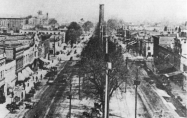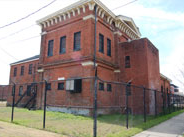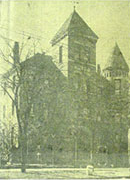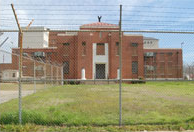History of the Sheriff's Office

(1862 - Present)
In 1825, the Houston County Sheriff was the only law enforcer for the territory that later became Muscogee County. In an act passed by the House on December 8, 1826, and by the Senate on December 11, 1826, the General Assembly split the territory secured from the Indians in the 1825 Treaty at Indian Springs and sliced it into five portions. Muscogee County was the second slice, laid out north of the old early county line, stretching from the Chattahoochee to the Flint Rivers.
The act to establish Muscogee County called for an election to be held the first Monday in May 1827. The law established an Inferior and Superior Court and the original county government that consisted of five judges of the Inferior Court, Tax Collector, Tax Receiver, Coroner, County Surveyor, and Sheriff. The election was held in the home of William Osburn. According to the inventory of the County archives of Georgia, Governor Troup issued commissions to the first county officers. Listed among the officers was James P. Portis, Sheriff. The first actual Office of the Sheriff of Muscogee County was established in 1828, consisting of Sheriff James C. Holland and Deputy Pleasant Robinson.
Through the years, the Sheriff's Office has grown with the needs of the county as well as the region. In the early years, the Sheriff maintained the peace throughout the county as well as many other duties. One of those duties was, and still is, to maintain the county jail. Another duty of the Sheriff that has remained strong through the years is the maintenance of the courts.
The progression of the Sheriff's Office through the years has been a slow process. From 1828 until 1898, the office generally consisted of the Sheriff, one Deputy, and one Jailer. Records show that during Sheriff Jesse Beard's term of office from 1911 to 1928, he had eight Deputies employed. The first Chief Deputy on record was John D. Skotzky, who served as Chief Deputy for Sheriff A. L. Poole from 1938 to 1943. The Muscogee County Sheriff's Office budget records for the fiscal year 1968-69 show the office as employing 28 persons.
On September 1, 1969, the Sheriff's Office absorbed the County Police Department. Needing a Criminal Investigative arm in the county, an Investigative/Intelligence Unit was formed to handle all major crimes in the county outside the city limits, as well as internal investigations involving employees. After Government Consolidation took place in 1971, a Crime Control Unit and a Fugitive/Warrant Division were formed to execute all fugitive warrants in the county. A need rose in the county for a full time Narcotics Unit. The Metro Narcotics Task Force, which consists of officers from the surrounding counties in Georgia and Alabama, was developed in 1989. The Sheriff's Criminal Investigations Unit has slowly shifted its role from vice-type crimes to complex white-collar and fraud crimes. In 1996, to counteract the increase in the violent nature of crime in our society, and with the coming of Olympic competition to Columbus, the Sheriff's Office began a Special Response Team (SRT). The SRT team is made up of a select group of elite Deputies who give up their off-duty time to train in areas such as hostage rescue, high-risk warrant service, firearms training, martial arts, and physical agility training. These Deputies are on call 24 hours a day and are ready to respond to any situation as needed.
The Muscogee County Sheriff's Office has evolved from one Sheriff and one Deputy in 1828 to one of the most highly respected Sheriff's Offices in the State of Georgia. The Sheriff's Office is dedicated to continuing to provide the citizens of Muscogee County and Columbus with the best professional service possible. We are able to do this through our commitment to continuing education and keeping up with the changing technology of our advancing society. We are committed to building on the past and preparing for the future.
(The Stockade, circa 1850 - 1870)

It is not certain when the Columbus Stockade was built or what it was originally used for. It has been documented that the Stockade was listed in the 1858 City Directory and an 1872 map indicates that it served as a "detention institution." The jail facility was referred to in Haddock's Columbus, Georgia Directory 1873—1874 as "The jail, a large handsome brick structure, is situated on the East Common. It was completed with all modern improvements about the time of the breaking out of the late war. The cells are of iron and are well ventilated. It is considered entirely safe." There is an interior iron door that has a plaque stating, "Wrought Iron. Plate Jail. Patented Dec 20, 1859. Valleau & Jacobs Cin. O." It is not known whether the doors were installed in the Stockade in 1859 or if the doors were made in 1859 and later sold, shipped, and installed in the Stockade.
The Columbus Stockade was placed on the National Historic Register in 1980. It is one of the oldest and finest examples of Renaissance Revival architecture in Columbus. The architectural detail of ornamental bricklaying, indicative of the mid-1800's period, is considered to be one of the finest examples remaining in the city. The structure was originally two separate buildings. In the 1870's, the two structures were joined by a brick corridor and in 1930; additions were made to the City Stockade by F. Roy Duncan, Architect, J. P. Bradfield, Contractor.
In 1927, the singing and guitar- picking duo of Thomas P. (Tom) Darby of Columbus and Johnny J. (Jimmie) Tarlton of Phenix City wrote, recorded, and released the now classic song, "The Stockade Blues" also known as "Way Down In Columbus, Georgia." The record soared in popularity throughout the nation and reportedly sold millions at a time when the recording industry was in its infancy.
(Muscogee County Jail - circa 1890's)

This Muscogee County Jail was constructed in the 1890's. A July 10, 1892, notice declared, "The lot on which the public building is to be built has been entirely cleared." This facility stood for 45 years. It "exploded" in the early morning hours of October 21, 1938. The explosion destroyed almost all of the building. It is believed that the explosion was caused by an accumulation of gas in the basement from a failure of the safety valve after the burner pilot went out or a leaky main.
At the time of the explosion, the structure was regarded as one of the most secure jails in the state; however, it was once the scene of mob violence. Since then, the jail had been threatened by crowds, but never entered. But during the jails last few years of usage the jail had been regarded as too small and inadequate for present day use. Its normal capacity was 72 prisoners. Like most old jails, this structure went through some rather hectic experiences and housed some noted criminals.
(1939 Jail)

Due to the explosion of the County Jail on October 21, 1938, a new and modern jail was built. The county's share of the cost was estimated to be around $73,000.00; however, it was built at a cost of $140,000.
The 1939 jail was designed by F. Roy Duncan and T. F. Lockwood, Architects and built by Williams Lumber Company, Contractor. The plans called for concrete and steel construction for the two-story building. The plans allowed space to house between 170 and 200 prisoners. The plans also called for a hospital and clinic.